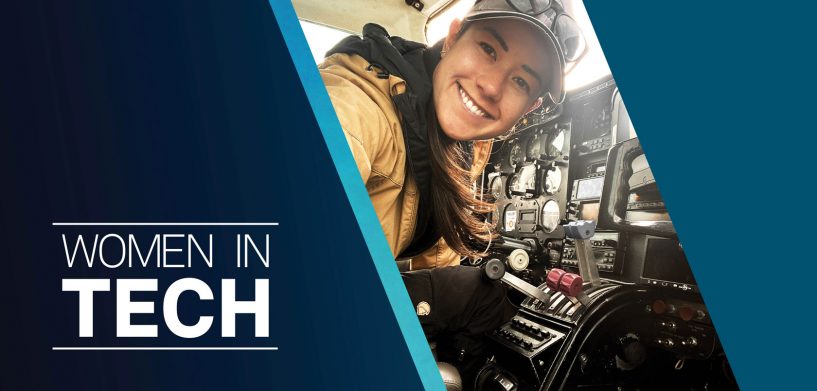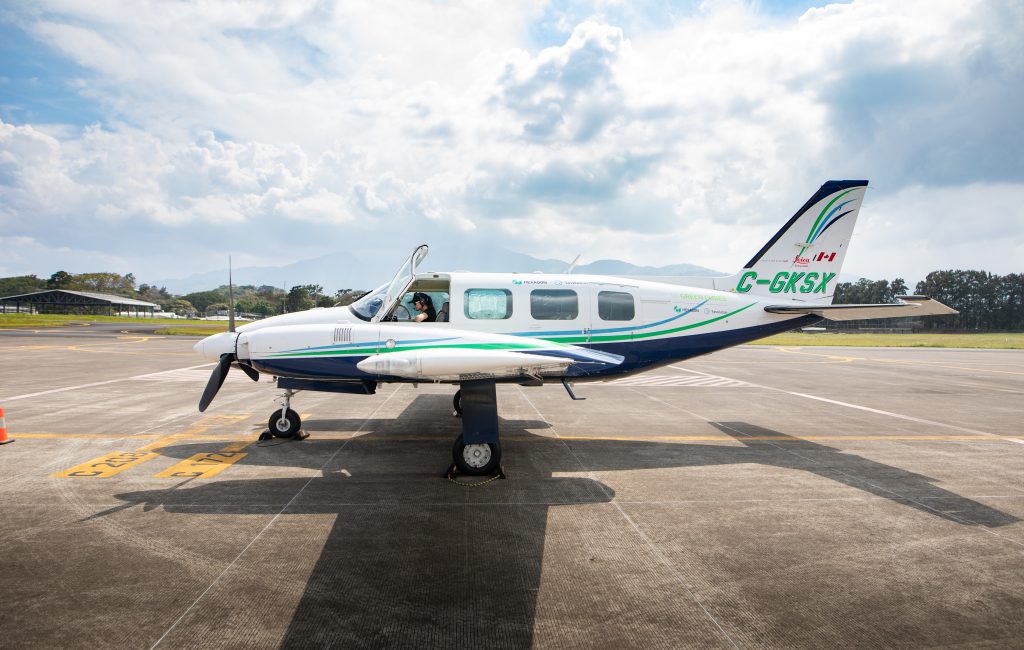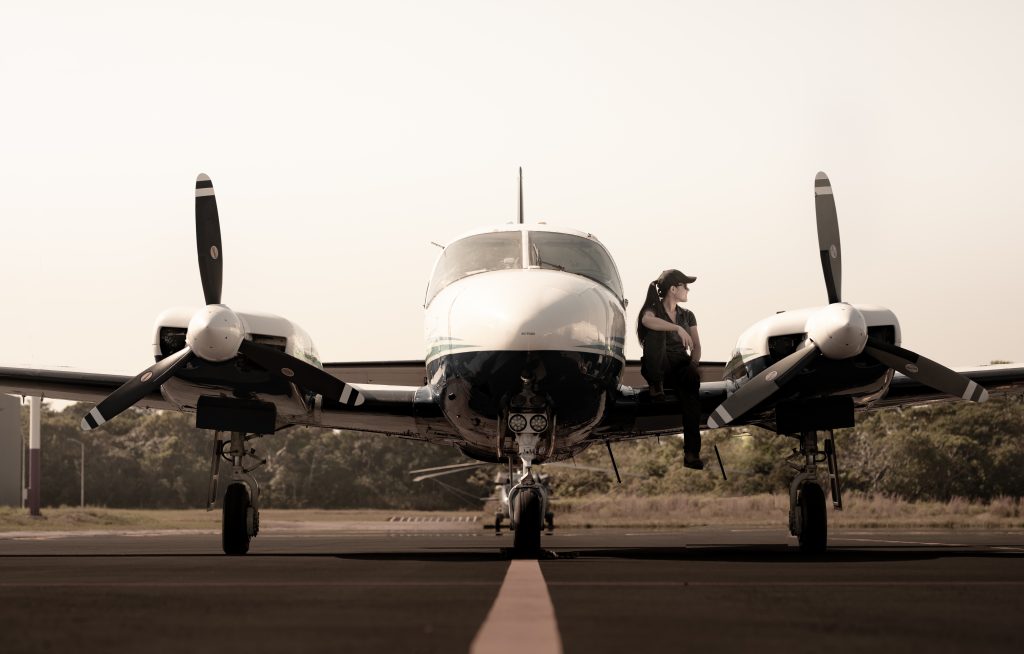Outstanding and innovative journeys in technology come in all forms, and not all take place behind the computer screen. Today, we are honoured to be joined by Natalie Gillis, a PA31 Captain and survey pilot with KASI Aviation, part of Hexagon. Natalie is one of the pilots working with R-evolution’s Green Cubes project, a digital revolution for rainforest conservation that provides precise volume, health assessments and biodiversity trends of rainforests at scale, collaborating with scientists and local communities to strengthen conservation efforts.
She most recently flew for an initiative that is aiding the preservation and expansion of the COBIGA corridor in Costa Rica, a vital link between two essential national parks home to numerous unique and endangered species. We sat down with Natalie to discuss her aviation career and experience with Green Cubes.
What led you to choose aviation as a career, and how did that lead to working with KASI Aviation and R-evolution?
It’s a second career for me, so I got into it later in life. I initially worked as an expedition guide, leading expeditions in the High Arctic and Antarctica. These were mostly self-supported — we went out with our kayaks, food, tents and everything we needed to be out there for about two to three weeks at a time. To get to some of the more remote locations, you’d have to charter an airplane. So, I always had it in the back of my mind… I loved the airplane ride and the experience with these incredible machines that could take you to these faraway places, and I told myself that I had to pursue that at some point in my life.
It took a bit of time, but with travel at a standstill during the pandemic, I had the opportunity to take a substantial break. This allowed me to complete all the necessary ratings and licensing. I then secured a position with a company based in Calgary — the same one from which I had chartered plane rides in the Arctic. Remarkably, I found myself piloting some of the very airplanes in which I had been a passenger for many years.
Eventually, it was the right time in my career that I wanted to slide over to the left seat and get some experience being a captain; that’s how I found KASI Aviation, who were nice enough to give me a seat on one of their Navajo aircrafts. It’s been wonderful ever since, and I’ve been enjoying the survey world. It’s allowing me to go to lots of really cool places and experience lots of great things.
Can you walk us through the process behind the surveying you’ve been doing in Costa Rica?
Flying the Navajo, you have a screen in front of you with the survey line, and you can’t be drifting, you can’t be climbing, you can’t be descending. You have got to be on your line. There isn’t a lot of opportunity for sightseeing because you’re looking around for other air traffic, checking on weather patterns, monitoring how close you’re getting to terrain, staying up on the wind conditions… you’re very focused on having your airplane be exactly where it’s supposed to be.
For this project, we have two pilots on board and an operator in the back from Hexagon operating the sensor. My job in the front is to make sure that I’m flying that airplane to give the sensor the best platform to capture the most accurate data according to the parameters of the project.
The big thing about this project was that we couldn’t have cloud cover to get the scans, but it’s Central America. It’s right by the ocean, so typically, the mornings would be covered by fog lingering in the valleys and by early afternoon, all these huge cumulus clouds would start popping up. We only had a narrow window — from about 9 to 11 a.m. — to capture data without cloud shadows.
You mentioned that you had just two pilots working on the project. Green Cubes is capturing 125 million cubic metres of scans for this area, which seems like an enormous amount of work. How did you manage to do it with just the two of you?
A typical day at KASI is mostly single-pilot operations, so it was nice to have someone else there for this project because we could divide the work. The co-captain on board was a wonderful guy I’ve worked with before. We would alternate who was sitting in the left seat, and the other would serve as First Officer in the right seat, doing all the radio work and monitoring systems as much as possible while that pilot was more focused on the survey lines. And then if they get tired or want to have a swig of water or whatever, they’ll say, “You have control”, and then you fly your survey lines for a couple of minutes while they have their break. It worked out well. I got to play with my camera on this project, which I was excited to have because it’s not something I usually get to do with a job in aviation.
That photographer’s eye must be useful since you’re seeing all these different environments from above.
Yeah, absolutely. I was fortunate with my previous role that I got to go to some pretty remote areas. In 2023, I started from the South Pole and flew across Antarctica, up through South and Central America, and to Northwest Greenland. After that , I was able to fly all over the Canadian high Arctic, and then off to Europe to do surveying out there, and then back to Canada and all over the United States. It’s a unique way to see the world, and I’d say that it makes the world make a lot more sense .
When you see the landscape in these huge continuous swaths, it adds another dimension to atlases and maps because you’ve seen it in real life, especially in airplanes that typically fly at lower altitudes and slower speeds. You can see the whole world pass by you outside of your window, and it makes it seem not as mysterious. You also learn to feel things like air density and altitude.
It also allows you to observe firsthand how the landscapes are constantly changing. I’ve spent about 12 years returning to the Arctic, and you notice that the glaciers are different now.
It seems you’ve got a special place in your heart for the Arctic.
Where do I begin? Yeah, it’s incredible. It’s vast and beautiful. It is dark in the winters, but you get continuous daylight in the summers; there’s so much going on up there, even though you can go forever and not see anything that’s been altered. It’s a beautiful wilderness area. The Antarctic is incredible for wildlife like whales, penguins, sea birds, you name it.
But Costa Rica has been one of those special places for me, too. I did a big hike back there in 2009 for a guide training course, so I spent about three months down in the same area we were surveying over with R-evolution, which made it cool to be back there and seeing it from the air. There’s such a huge wide world out there, so there are many things I want to keep doing and places to see.
That’s interesting because when people think of pilots, they probably imagine commercial air travel. Still, all these amazing aviation jobs and experiences are available — can you talk more about that?
If you’re not directly involved in the aviation world, it can be hard to wrap your brain around all the different opportunities, but you can do so much. Forest firefighting is a big thing in the summer when you have air tankers and bird dogs that must manage and control wildfires. There’s medevac flying, where you’re getting to people that need to get to advanced medical care very urgently, there’s bush flying, where you’re taking people to remote places that only an airplane can reach, and there’s specialty work that pretty much does everything under the sun.
I flew around Will Smith when he was doing his documentary filmmaking out on the ice in Antarctica, which was cool. And then there’s a survey, another adventurous side of aviation. I was doing this stuff in Costa Rica, and on the way back, KASI asked me if I could do some surveying over downtown Miami. It’s so different and diverse; no two days are ever the same.
We’re gathering stories from exceptional women in their fields for this series, and aviation has been an infamously male-dominated industry for a long time. There’s still work to be done, but what kind of progress have you seen in your experience?
I get this question frequently and always have the same answer: I’m here because other women broke down the barriers. They did a lot of hard work that allows people like me to worry less about that and to come in with the attitude that you show up and do the job as best as you can, just like anybody else. I think I was super lucky in my aviation career that many wonderful women mentored me, and it was just a normalised thing.
The only time I think about being “a woman in aviation” is when a passenger points it out because they think it’s cool to see me in that seat. And I think that’s a product of the women who have come before me. It’s helpful when you notice that you’re not the only one who does not fit the stereotypical mould.
We’re about out of time, so here’s a moment to pass on some lessons of your own: if you could speak to women and girls who might be interested in going into aviation or don’t know that it’s an option for them, what would you like to say to them?
I was very lucky to have the opportunity to discover the non-commercial aviation world because it is so niche, and it was amazing to stumble upon it and be like, “Oh wow, this is a cool thing that I could do if I worked hard for it.” So, I think the advice I would give is that building the skills to do anything, including aviation, requires hard work and a lot of dedication. It’s a lot of persistence and a serious commitment to growth every single day.
You’re never going to be perfect — you just wake up every day, and you want to be a little bit better at your job than you were the day before. So, you open a book, you do a little studying, or whatever else needs to be done. You have to commit to growing every day and making yourself a little bit better. Just have goals and chase after them.
Natalie Gillis is a PA31 Captain with KASI Aviation, part of Hexagon, and an experienced nature photographer. You can find examples of her work on her website and follow her on LinkedIn to learn more.



















